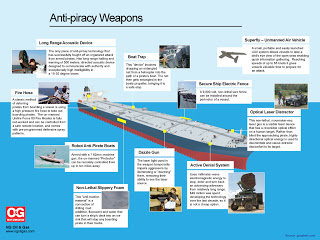Next Generation Oil and Gas covered the issue of piracy. The US-flagged container ship Maersk Alabama repelled an attack by suspected pirates off the northeast coast of Somalia. According to a statement from the US 5th Fleet, when a pirate skiff approached the ship, the security team on board responded with evasive maneuvers, and blasted them with Long Range Acoustic Devices (LRADs) and small-arms fire. The pirates then broke off the attack.
Ships often need better radar to detect the small boats used by pirates.
Current ship-based radar systems are designed to prevent collisions at sea, or to detect threats from the sky.
Holographic radar is a non-scanning, continuously tracking 3D radar that provides persistent illumination of its field of view and can resolve and measure an object’s motion at fine scale, as well as its range and direction. It is currently being scaled up for use on wind farms to offer infill coverage for air traffic control and military surveillance radars, but if adapted appropriately for a marine surveillance application and placed at prominent points on a vessel’s superstructure, it would enable a crew to detect small boats and take evasive manoeuvres or trigger self-defence mechanisms to repel a pirate attack.
Piracy statistics released by the International Maritime Bureau (IMB) Piracy Reporting Centre (PRC) point to a significant increase in attacks by pirates in the first nine months of 2008. According to a PRC press release, reported acts of piracy committed up to late October 2008 have included 115 vessels boarded, 31 vessels hijacked, and 23 vessels fired upon, seeing a total of 581 crew members taken hostage, nine kidnapped, nine killed and seven missing, presumed dead.
Fire hoses, robot boats and dazzle guns are other forms of anti-piracy devices that are more commonly used by other large vessels such as container ships, but oil tankers have cargo well worth protecting.
In November 2008, pirates hijacked the Saudi supertanker Sirius Star, which held 2 million barrels of oil valued at about $100 million. The tanker was released last January for a reported $3 million ransom after a two-month drama that helped galvanize international efforts to fight piracy off Africa’s coast
.
More pictures of anti-pirate weapons are at this gcaptain link
Another set of 10 anti-pirate weapons from gcaptain
EVASIVE MEASURES
* Alert crews are the key, shippers and security experts say. Pirates need to be spotted and evasive action taken long before they are within rocket range.
* Vessels are recommended to sail at least 600 nautical miles from the shore to avoid attack.
* Captains are advised to drill their crews in simulated attack to practise evasion techniques.
* Maritime organisations advise ships to put barbed wire and barriers around the ship and dummies to simulate lookouts.
* A distress call to naval forces should be made when a pirate boat is sighted.
* Ships are urged to speed up and manoeuvre to increase the choppiness of the water around the pirates’ speedboats.
* Pirates allow 30-45 minutes on average for boarding and will give up if boarding proves too difficult, the IMB says
.
EHow on maritime anti-piracy security training
2009 – a Russian anti-pirate weapon
If you liked this article, please give it a quick review on ycombinator, or Reddit, or StumbleUpon. Thanks
Featured articles
Ocean Floor Gold and Copper
Ocean Floor Mining Company

Brian Wang is a Futurist Thought Leader and a popular Science blogger with 1 million readers per month. His blog Nextbigfuture.com is ranked #1 Science News Blog. It covers many disruptive technology and trends including Space, Robotics, Artificial Intelligence, Medicine, Anti-aging Biotechnology, and Nanotechnology.
Known for identifying cutting edge technologies, he is currently a Co-Founder of a startup and fundraiser for high potential early-stage companies. He is the Head of Research for Allocations for deep technology investments and an Angel Investor at Space Angels.
A frequent speaker at corporations, he has been a TEDx speaker, a Singularity University speaker and guest at numerous interviews for radio and podcasts. He is open to public speaking and advising engagements.


